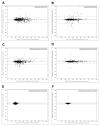Reproducibility of spectral-domain optical coherence tomography retinal thickness measurements and conversion to equivalent time-domain metrics in diabetic macular edema
- PMID: 25058482
- PMCID: PMC4366946
- DOI: 10.1001/jamaophthalmol.2014.1698
Reproducibility of spectral-domain optical coherence tomography retinal thickness measurements and conversion to equivalent time-domain metrics in diabetic macular edema
Abstract
Importance: Understanding measurement variability and relationships between measurements obtained on different optical coherence tomography (OCT) machines is critical for clinical trials and clinical settings.
Objective: To evaluate the reproducibility of retinal thickness measurements from OCT images obtained by time-domain (TD) (Stratus; Carl Zeiss Meditec) and spectral-domain (SD) (Cirrus; Carl Zeiss Meditec, and Spectralis; Heidelberg Engineering) instruments and formulate equations to convert retinal thickness measurements from SD-OCT to equivalent values on TD-OCT.
Design, setting, and participants: A cross-sectional observational study was conducted in private and institutional practices. Persons with diabetes mellitus who had at least 1 eye with central-involved diabetic macular edema, defined as Stratus central subfield thickness (CST) of 250 μm or greater, participated. An additional normative cohort (individuals with diabetes but without diabetic macular edema) was enrolled. Each study eye underwent 2 replicate Stratus scans followed by 2 replicate Cirrus or Spectralis scans (real-time image registration used) centered on the fovea.
Main outcomes and measures: Optical coherence tomography CST and macular volume.
Results: The Bland-Altman coefficient of repeatability for relative change in CST (the degree of change that could be expected from measurement variability) was lower with Spectralis (7%) compared with Cirrus (14%) and Stratus (12% and 15% within Cirrus/Stratus and Spectralis/Stratus groups, respectively). For each cohort, the initial Stratus CST was within 10% of the replicate Stratus measurement nearly all of the time; the conversion equations predicted a Stratus CST within 10% of the observed thickness 86% and 89% of the time for Cirrus/Stratus and Spectralis/Stratus groups, respectively, which is similar to the agreement on Stratus test-retest. The Bland-Altman limits of agreement for relative change in CST between machines (the degree of change that could be expected from measurement variability [combining within and between instrument variability]) were 21% for Cirrus and 19% for Spectralis when comparing predicted vs actual Stratus measurement.
Conclusions and relevance: Reproducibility appears to be better with Spectralis than with Cirrus and Stratus. Conversion equations to transform Cirrus or Spectralis measurements to Stratus-equivalent values, within 10% of the observed Stratus thickness values, appear feasible. Central subfield thickness changes beyond 10% when using the same machine or 20% when switching machines, after conversion to Stratus equivalents, are likely due to a change in retinal thickness rather than measurement error.
Conflict of interest statement
Figures



References
-
- The Diabetic Retinopathy Clinical Research Network. Randomized trial evaluating short-term effects of intravitreal ranibizumab or triamcinolone acetonide on macular edema following focal/grid laser for diabetic macular edema in eyes also receiving panretinal photocoagulation. Retina. 2011;31(6):1009–27. - PMC - PubMed
-
- Bland JM, Altman DG. Measuring agreement in method comparison studies. Stat Methods Med Res. 1999;8(2):135–60. - PubMed
Publication types
MeSH terms
Grants and funding
LinkOut - more resources
Full Text Sources
Other Literature Sources
Medical

